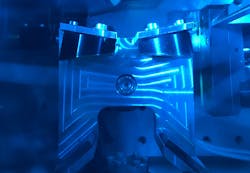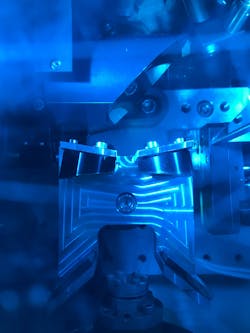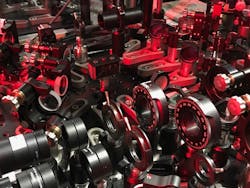Narrowband tunable terahertz lasers may transform materials research and technology
A group of Max Planck Institute for the Structure and Dynamics of Matter researchers in Germany, who explore the effect of manipulating the properties of quantum materials away from equilibrium via tailored laser drives, discovered a far more efficient way to create a previously observed metastable, superconducting-like state in a fullerene-based material (K3C60) using laser light.
By tuning the light source to 10 THz, a lower frequency than previously possible, the group recreated a long-lived superconducting-like state in the fullerene-based material while reducing the pulse intensity by a factor of 100. While the researchers managed to directly observe this light-induced state at room temperature for 100 picoseconds, they predict it has a lifetime of at least 0.5 nanoseconds.
“We’ve been interested in the nonlinear response of materials for quite a few years—especially how molecular modes or phonon modes in solids can be driven to large amplitudes,” says Andrea Cavalleri, founding director of the Max Planck Institute for the Structure and Dynamics of Matter, as well as a physics professor at the University of Hamburg and the University of Oxford. “Many new phenomena occur within this regime, and one of these is the amplification of electronic properties like superconductivity.”
The group’s findings can help reveal more details about the underlying microscopic mechanism of photo-induced superconductivity. “Identification of the resonance frequency will allow theorists to understand which excitations are important, since there’s no widely accepted theoretical explanation of this effect in K3C60,” says Edward Rowe, a Ph.D. student working with Cavalleri.
And a light source with a higher repetition rate at the 10 THz frequency may help sustain the metastable state longer. “If we can deliver each new pulse before the sample returns to its non-superconducting equilibrium state, it may be possible to sustain the superconducting-like state continuously,” says Rowe.
Amplification of superconductivity
The group’s work is based on the excitation of lattice vibrations, which are then coupled to the electronic degrees of freedom of the system through electron phonon coupling.
“Although the microscopic physics is far from clear, it appears that a coherent modulation of these modes can ‘cool’ fluctuations within the superconducting electrons, reducing decoherence and stabilizing superconductivity at temperatures impossible in a non-driven system or equilibrium system,” says Cavalleri.
A new class of physical phenomena is waiting to be studied and exploited—it has to do with controlling the functionality of materials with light. “The bottleneck at this stage is the availability and complexity of mid-infrared and terahertz sources, which are mostly broadband single-cycle sources,” explains Cavalleri. “Narrowband tunable lasers and amplifiers capable of covering the spectral region between 1 to 20 THz will have a transformative impact on materials research and technology.”
The group’s results are coming after a decade of research, and their advances are the result of a systematic characterization of the materials’ response pump frequency. “But a 100-fold enhancement in efficiency was a striking and unexpected result—and very rewarding,” Cavalleri says.
There were several challenges along the way. The “design of the optical parametric amplifier, its operation under stable conditions, and the preparation of K3C60 samples were all very challenging,” Cavalleri adds.
High-speed devices ahead?
While it’s too early to know exactly what types of applications the team’s work will enable, “if these materials can be engineered to the same standard as superconducting platforms used for magnetic manipulation and sensing, or electrical transport, and if terahertz lasers become more widely available outside of a complicated laboratory setting, we can envision applications in high-speed devices,” Cavalleri says.
What’s next for the team? “We’re now developing platforms to study the magnetic and electrical response of these materials, and are interested in exploring the effects of quantum tunneling under a laser drive,” says Cavalleri.
FURTHER READING
E. Rowe et al., Nat. Phys. (2023); https://doi.org/10.1038/s41567-023-02235-9.
About the Author
Sally Cole Johnson
Editor in Chief
Sally Cole Johnson, Laser Focus World’s editor in chief, is a science and technology journalist who specializes in physics and semiconductors.



